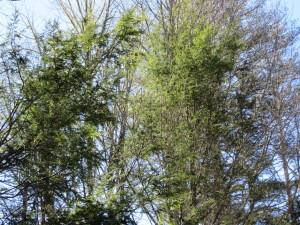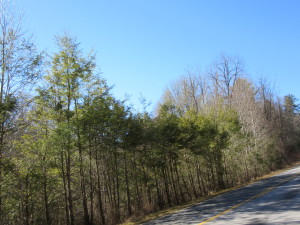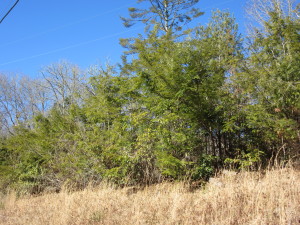Hemlock Restoration – How to Tell if the Predator Beetles are Working
The Process of Hemlock Restoration
Hemlock Restoration in HWA-damaged areas requires introducing biological agents to control the Hemlock Woolly Adelgid. The purpose of biological control is to create natural environments in which our native hemlocks can recover and resume normal foliage growth and development while co-existing with HWA. And the best way to tell whether this hemlock restoration is working is to observe the hemlocks’ response to the introduction of Sasajiscymnus tsugae HWA predator beetles! For more discussion about assessment strategies for HWA predator beetle releases, go to Assessment.
The key to assessing HWA predator beetle effectiveness is monitoring the hemlocks themselves for signs of new foliage production and restoration of foliage growth in the years following a release. Heavy HWA infestations damage hemlocks in two ways. First, while each adelgid will only destroy a single hemlock needle, their two cycle HWA reproductive season can produce exponential growth, resulting in the millions of HWA needed to defoliate any hemlock in their path. Second, an HWA infestation of 45% of a hemlock’s existing foliage will suppress the production of new foliage growth. And the combination of massive foliage loss with no new foliage production can be a deadly combination for our native hemlocks.
But predation by Sasi/St predator beetles breaks this destructive cycle, reducing the loss of existing hemlock foliage and initiating new foliage growth need for hemlock recovery. So the onset of new hemlock foliage growth after predator beetle releases in a damaged hemlock area is an important sign that the beetles are successfully reducing the HWA infestation and promoting hemlock restoration. And the good news, as the photos below illustrate, is that hemlock restoration in the field is easy to observe and document … and a welcome change from the cycle of hemlock death and destruction that can be so readily visible in our wild hemlock areas!
Another benefit of Sasajiscymnus tsugae predation in heavily HWA-infested hemlock areas is to initiate a natural selection process for hemlock resistance to the Hemlock Woolly Adelgid. While some large hemlocks will typically be lost in initiating HWA biological control for heavily infested hemlock areas, some of the larger surviving hemlocks (see below) will be selected for a higher level of natural resistance to our HWA import from Southern Japan. And these survivors will provide genetic stock for upgrading biological resistance in succeeding generations of both of our native hemlocks (Tsuga canadensis and Tsuga caroliniana). For more information on biological resistance to HWA, see Resistance.
What Does Hemlock Restoration Look Like?
All of the photographs below are from Sasajiscymnus tsugae release sites in Western North Carolina, in the vicinity of the Horsepasture River and the western entrance to North Carolina’s Gorges State Park. The hemlocks in this area had experienced HWA infestations beginning around 2003. And by the time of the private Sasi releases in 2007-8, all hemlocks were experiencing significant foliage damage.
The first set of photographs will help address the question: What does hemlock restoration look like? On the right is a pair of large hemlocks, growing in full sun, in the 2007 release area for 100 Sasi predator beetles. These trees show the damage of HWA infestation on their lower branches, but they also show the exuberant healthy foliage growth on the crowns and extending down to lower branches that signifies that hemlock restoration is underway. On the left is a group of small hemlocks at the Gorges State Park entrance that received beetles from the across-the-road release of 100 predator beetles. This demonstrates the power of small predator releases to promote hemlock restoration, as Sasi’s exponential population growth powers a roll-out from the release site to adjoining areas.
Roll-out site Release site
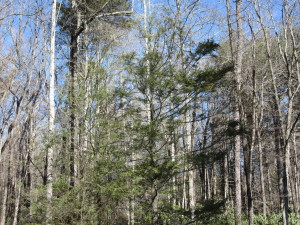
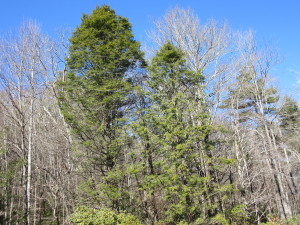
Continuing down the Highway (NC 281) to the Horsepasture River crossing takes us to a site where about 200 predator beetles were released in 2008. The larger riverside hemlocks were already badly damaged by HWA at the time of release, but one of the two at a release site has survived and is producing new foliage in an effort to recover. And as we proceed south along the path of the predator roll-out, we can see more examples of recovering hemlocks extending 1/2 mile along the roadway.
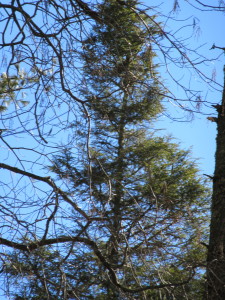
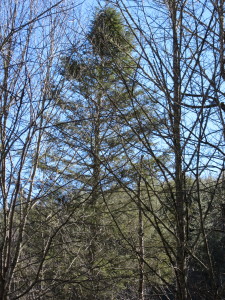
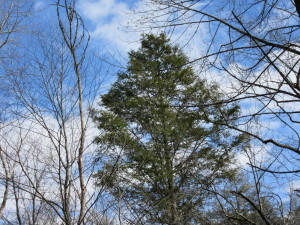
This trail of hemlock recovery culminates in about 1/2 mile with a pair of unmanaged hemlock hedges that are in the process of beetle-assisted restoration, despite side-shearing by DOT on the left and top-shearing by the utility company on the right. These hedges offer a great base for growing and extending Sasajiscymnus tsugae predator populations to adjoining areas .
Predator Beetle Roll-outs
This sort of trail of recovering hemlocks can be found in the vicinity of most Sasajiscymnus tsugae predator beetle releases, so long is there is sufficient food at the release site to support the predator beetle reproduction cycle. And such hemlock recovery is the best indicator of predator beetle effectiveness!
Similar episodes of hemlock restoration and recovery are readily visible in the vicinity of the larger scale USFS releases of Sasajiscymnus tsugae on public lands, and on waterways entering and emerging from National Forest release areas. My favorite USFS local predator beetle roll-out area is on both ends of the North Fork Gorge of the French Broad River (in Pisgah National Forest). Especially noticeable is the southern rollout onto private property which extends several miles west, from the junction of the West and North Forks of the French Broad River along the lower West Fork and in easy view along US Hwy 64W.

